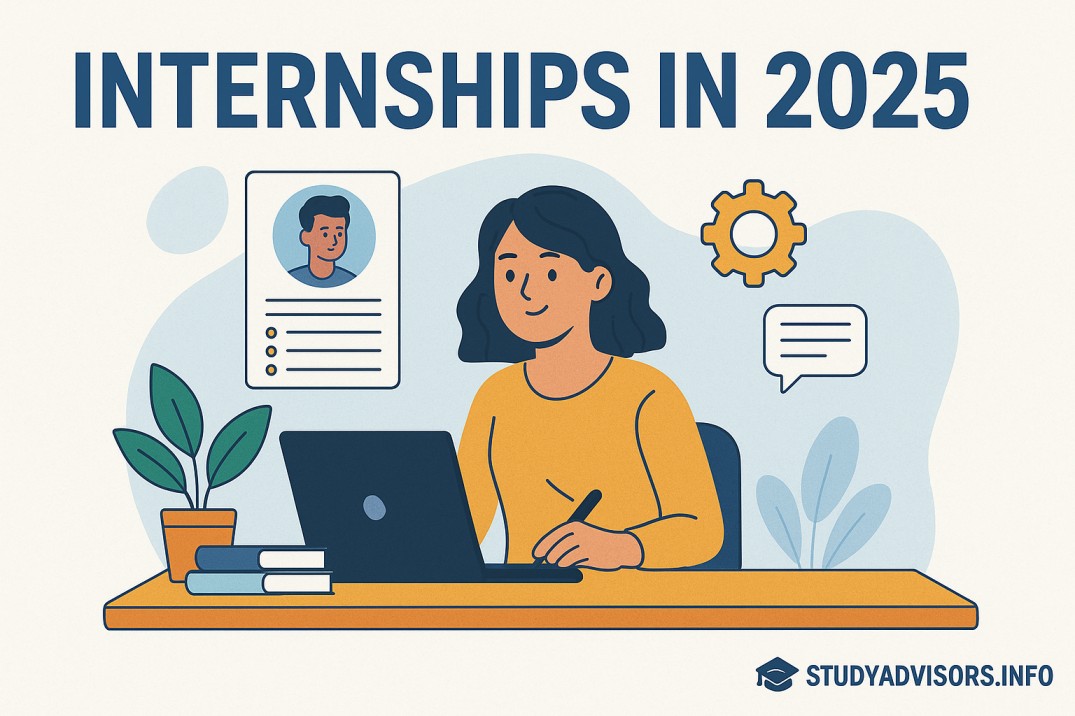On the first Monday of March, Aisha and Rohan both opened their laptops to apply for summer internships. Aisha had a small GitHub demo and a one-page resume tailored to three roles. Rohan had a long CV and thirty open tabs. Two weeks later, Aisha had two interviews and a coffee chat on the calendar. Rohan had automated rejection emails.
What changed the outcome wasn’t luck. It was a simple approach that works across industries in 2025: show a little proof, reach a real human, and follow up once with something new. This guide turns that idea into a complete path—from picking a direction to negotiating your offer—so you don’t rely on hope or spam. You won’t need perfect grades or famous contacts; you will need a small, visible result and the courage to send thoughtful messages.
Why internships feel harder now (and how to make them easier)
There are more applicants, faster applicant-tracking systems, and earlier deadlines at big firms. That combination makes the process look random from the outside. It isn’t. ATS filters reward relevant keywords; recruiters reward clarity; teams reward proof of value. If your application keeps disappearing, it’s usually because you’re trying to be everything to everyone. You’ll move faster once you pick a single direction and gather evidence for it.
Think of your application as a short story: who you are, what you’ve built, and how that helps this team right now. When the story is tight, the portal becomes a doorway instead of a wall.
Choose a direction before you send anything
Start with one sentence you can actually say out loud:
“I’m a [year/degree] who built X that did Y, now targeting [role] so I can deliver Z.”
“Second-year design student who redesigned a booking flow that cut steps by 22%, targeting UX intern roles to test changes with users.” That’s specific. It tells the reader what to do with you. You’ll use this line on your resume, in your portfolio, and in the first two sentences of your emails.
If you truly can’t pick a lane, choose two adjacent roles (for example, Data Analyst + Business Analyst, or UX + Product Design) and create one proof piece for each. You’ll still look focused.
Build a tiny proof in fourteen days (even with “no experience”)
You don’t need a giant app or a lab full of equipment. You need something small that works and teaches you a metric you can talk about.
- Software / Data: take a public dataset, write a tidy notebook or script that cleans it and answers one question, then host a simple demo. Add a README that says what changed—“reduced processing time from 1.6s to 0.9s,” “classified 1,000 rows at 96% accuracy,” “generated a chart that reveals X trend.”
- Design / UX: pick a student app or campus website and fix a single journey. Show before/after screens, three insights from five-minute user tests, and a short conclusion. A one-page case study beats fifty screenshots.
- Business / Marketing: analyze a brand’s funnel and propose three low-cost tests. Mock a dashboard in Google Sheets. Estimate impact and explain why your test should be first.
- Bio / Health / Research: replicate one figure from a paper or public dataset, note any limitations, and write two lines about what you would test next.
- Engineering: model a part, improve a design by one parameter, or simulate a small system. Keep assumptions honest and show a diagram.
Aisha’s entire “portfolio” was a two-page case study and a 90-second Loom video. It was enough. Her emails linked to something tangible; recruiters didn’t have to imagine her skills.
Your resume: one page, built for skimming
A human scan is ten seconds. Write for that moment. Put your projects above experience if the projects are stronger. Each bullet should read like a result, not a job description:
- “Automated weekly Excel reporting with Python, cutting manual work by 35%; deployed to Google Drive.”
- “Redesigned course registration flow; 22% faster completion in five peer tests.”
Mirror the exact nouns your target role lists—only if true: “Pandas,” “SQL,” “Figma,” “CAD,” “SPSS,” “Tableau,” “PCR,” “ArcGIS.” Applicant-tracking systems look for those words. Recruiters do too.
Keep the format plain: clear headings, standard fonts, no tables or multi-column layouts that confuse parsers. Save as PDF. Name it FirstName_LastName_Intern_2025.pdf.

Portfolios and GitHub: small but sharp
Three solid items beat a noisy grid. For each project, include a short narrative: the problem, what you built, the tools, one or two screenshots, and how to run or explore it. If a link is broken, fix it today. If a screenshot is blurry, replace it. Imagine a time-pressed manager clicking for thirty seconds—what will they understand about you?
Where to look (and how to avoid time sinks)
Start with your university portal and alumni networks. Those channels often bypass the crowd. Next, go directly to company “Careers → Students” pages and set job alerts. LinkedIn works when you filter by Internship and Posted in the last 7 days. For startups, browse YC Jobs and Wellfound/AngelList; many founders hire close to the start date and care more about proof than pedigree.
Be cautious of listings that ask for “training fees,” hide the company name, or can’t be verified on LinkedIn. If it feels off, it probably is.
Outreach that sounds like a person, not a bot
A thoughtful email to one team lead beats twenty generic messages. Use your proof as the center of gravity, keep the ask small, and show you paid attention.
Here’s the shape:
- Line 1–2: your one-sentence value proposition, then a specific nod to their team/project.
- Line 3–5: one concrete result from your mini-project, with a link.
- Line 6: a small ask—permission to share a one-page resume and two samples, or a 10-minute chat.
- Sign-off: name, LinkedIn, portfolio.
Aisha’s first message to an alumni PM was eighty-nine words long. It mentioned the team’s latest release and linked to her two-page case. The reply arrived the same afternoon: “Happy to forward your resume. Can you chat Thursday?”
If you hear nothing, follow up once after five to seven days and add something new—“I added search to the demo and wrote a 120-word readme on the trade-offs.”
Timing and weekly rhythm
Big firms recruit three to six months early. Labs and mid-size companies, two to four. Startups, sometimes the month before. Don’t try to guess; send a few applications every week and run a steady cadence:
- Early week: apply to five thoughtful roles with small resume tweaks.
- Midweek: reach out to a human at each company—one alum, one team lead.
- End of week: follow up where it makes sense and ship a micro-upgrade to your proof.
This rhythm is boring. That’s why it works.
Interviews: what to prepare (and what to stop doing)
Interviews reward clarity. Most questions boil down to “Tell me about yourself,” “Show me how you think,” and “Give me a time you handled X.” You don’t need a script; you need compact stories and a calm way to explain your decisions.
Behavioral questions land better in the STAR shape: Situation, Task, Action, Result. Prepare five stories you can bend to almost anything: a time you led, a time you resolved a conflict, a time you made a mistake and learned, a tight deadline, and an instance where you took initiative. Practice them out loud. You’ll hear where you ramble.
Technical / case questions measure thinking, not perfection. Talk through assumptions, trade-offs, and why you chose one path over another. If you don’t know something, say so and lay out how you would find out. A tidy process is more impressive than a lucky guess.
Take-home tasks are where many candidates burn days. Don’t. Confirm scope in a single sentence, decide how many hours you’ll invest, and narrate trade-offs in a short README. Polish the final ten percent—labels, naming, tiny UX flourishes. That polish often separates offers from “thanks for your time.”
For international students: keep logistics simple
Ask about work authorization early. Align dates with your university’s rules. If the role is remote, confirm time-zone overlap and equipment expectations. Keep a polite template ready for department approvals and letters so you’re not hunting for forms under pressure.
Offers and negotiation: what matters besides money
If you’re lucky enough to choose, weigh the scope of the work, your mentor, the tools you’ll learn, and the culture as heavily as the stipend. When you negotiate, keep it respectful and specific: “Given that the role includes X and Y, is there room to adjust the stipend toward [reasonable range]? I’m excited about the team and want to focus fully.” If the budget is fixed, ask about project choice, pairing, or flexibility instead. You’re negotiating for a better learning environment as much as a number.
The 30-60-90 that turns an internship into a return offer
First 30 days: set up fast, ask simple questions, and ship one small improvement by the second week. Show you can make a dent in something real.
Days 31–60: own a small project. Write a one-page plan—problem, approach, milestones—and share it with your manager. Demo progress weekly. Document everything as you go; future-you will thank you.
Days 61–90: deliver the core, measure what changed, and create a brief readout for the team. Ask explicitly about conversion criteria. Managers appreciate people who don’t guess.
Rohan finally adopted this plan mid-semester. He built a tiny dashboard, sent five thoughtful notes, and landed two interviews. His first offer didn’t come from the portal; it came from the person who replied, “Your demo is close to what we need—let’s chat.”
Mistakes worth skipping on your first try
Don’t spray a hundred identical applications. Don’t send paragraphs of buzzwords to strangers. Don’t let a take-home eat your whole week. And don’t ignore your links. Most importantly, don’t vanish after one “no.” A calm, polite follow-up with something new is the most underused move in the search.
Final thoughts: the quiet advantage
The advantage in 2025 isn’t a secret network or a perfect GPA. It’s proof you can learn, proof you can ship, and a few clear sentences that help busy people see how you fit. Keep your proof small and visible. Keep your messages short and human. Keep going.

FAQs
Do I need a big portfolio to apply?
No. Two or three relevant pieces are enough if each one tells a clear story and includes a result you can talk about.
How long should I wait before following up?
Five to seven business days is polite. Add a small update—new screenshot, tiny improvement, or clearer readme—so it doesn’t feel like a nudge for the sake of nudging.
What if my GPA isn’t great?
Lead with projects and outcomes. Many teams will interview a candidate who shows initiative and clarity, even without a perfect transcript.
Is a one-page resume mandatory?
For internships, yes. If you genuinely need more space, your portfolio is where the extra detail belongs.
Should I learn a new tool before applying?
Only if that tool appears across many postings for your target role. Otherwise, ship something with the tools you know now and learn on the job.
Are unpaid internships ever worth it?
Set a short, clear scope and a hard end date. If it genuinely produces a strong proof piece or a likely paid extension, it can be a stepping stone. If not, skip it.
How do I stand out in interviews without sounding scripted?
Practice the beginnings and endings of your answers—the first and last lines—so you sound confident. Keep the middle conversational and specific.









